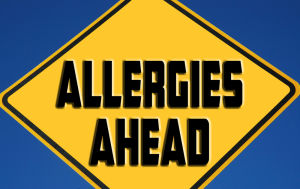Allergies loom, ready to attack with warmer weather
April 2, 2014
It’s that time of year again when allergies take center stage for some people, sneezing, runny nose, watery, swollen eyes and nasal congestion are a few of the symptoms borne by allergy sufferers. Allergies develop in about 30 percent of all people worldwide, and anyone can develop allergies even though they have never experienced them before.
An allergic reaction happens when the immune system overreacts to otherwise harmless antigens. The body responds by presenting symptoms, which can range from mild indicators like sneezing to life-threatening conditions like anaphylaxis.
Allergic shock or anaphylactic shock occurs when people develop severe reactions to an allergen, such as a bee sting or food, which can cause death if left untreated because many organs can be affected simultaneously. People at risk for life-threatening reactions can carry a portable dose of epinephrine in an EpiPen.
Allergic rhinitis, or seasonal allergies, attack as soon as the grasses, flowers and weeds start growing and the trees start blossoming. “Hay fever” is a misnomer because most people are not allergic to hay and don’t run fevers.
The average sufferer presents itchy, swollen eyes, rash, itchy ears, itchy skin, sinus congestion and wheezing. Other symptoms are hives, swollen throat, shortness of breath, stomach pain and nausea. Rhinitis can also lead to other diseases such as sinusitis and asthma.
Some allergens come from mold spores, dust and animal dander. Cockroaches can also cause allergies and protein from their droppings, saliva and appendages can cause allergic reactions. Doctors say that cockroach allergies have led to an increase in cases of asthma over the last 30 years.
Mold spores are microscopic allergens. There are many kinds that usually live in damp or wet areas. Bathrooms and basements are prime areas for molds. Cutting grass, spreading mulch and raking leaves can stir up mold spores and cause them to go airborne.
Tamika Willis, a senior information research studies major, says she developed allergies in her youth. She has seasonal allergies in the spring time and is also allergic to onions.
“I get really, really hot, feverish and start breaking out in rashes everywhere,” said Willis.
Willis thinks the pesticides they used around where she used to live in New Orleans were a major contributor to her allergies.
“I could go to the doctor and take medicine but I don’t like medicine so I just suffer until it is over,” said Willis.
Roxana Voica, a doctor at the Topeka Allergy and Asthma Clinic says that usually by this time of the year people are suffering with allergies. But it has been so cold this year that few people are having problems — yet.
“Know what you are allergic to and treat it accordingly,” said Voica. “Use avoidance measures, medications and immunotherapy as indicated.”
Treatment includes over-the-counter medications (anti-histamines), prescription drugs, a cortisone nose spray or allergy shots.
Voica says that trees are pollinating right now, including elm, cedar, sycamore and juniper. Mold spores are also flying around, though so far all pollen counts are still low and may start showing up as early as next week if it stays warm.
To check for pollen counts go to topekaallergy.com and click on the pollen count link.
Possible symptoms of allergic shock are:
- Hives or red skin discoloration
- Nasal congestion
- Throat swelling
- Stomach pain, nausea, vomiting
- Shortness of breath, wheezing
- Low blood pressure and shock
If someone is experiencing these symptoms they need immediate medical treatment as it can be fatal.



